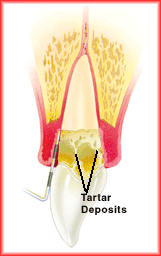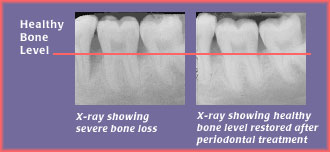 |
Soft Tissue Grafts
| Soft tissue grafts can be
used to increase gum tissue thickness or possibly
cover exposed roots where gum is absent due to
excessive gingival recession. During this
procedure your periodontist takes gum tissue from
your palate or another donor source to augment
tissue thickness or cover the exposed root if
possible. |
| A soft tissue graft can help inhibit further
recession. In some cases it can cover exposed
roots. This may reduce tooth sensitivity and
improve esthetics of your
smile. | |
 |
Frenetomy
| A frenotomy is the
surgical removal of a frenum in the mouth. A
frenum is a fold of tissue that passes from the
movable lip or cheek to the gum. A frenotomy is
indicated when a frenum is positioned in such a
way as to interfere with the normal alignment of
teeth or results in pulling away of the gum from
the tooth surface causing recession.
| |
 |
Gingivectomy
| Since the bacteria that
causes periodontal disease breed in the deepened
pockets between the gum and the tooth, your
dentists may attempt to eliminate the area in
which this bacteria can grow with a gingivectomy.
|
| In a gingivectomy, the
doctor will trim the unhealthy gum in order
to reduce the pocket size. As a result, the
bacteria will no longer have a suitable
environment in which to grow, and healthy gum
tissue can begin to grow back.
| |
 |
Pocket Reduction
Procedures
(Information from The American Academy of
Periodontology)
| Your bone and gum
tissue should fit snugly around your teeth like a
turtleneck around your neck. When you have
periodontal disease, this supporting tissue and
bone is destroyed, forming "pockets" around the
teeth. |
| Over time, these pockets
become deeper, providing a larger space for
bacteria to live. As bacteria develop around the
teeth, they can accumulate and advance under the
gum tissue. These deep pockets collect even more
bacteria, resulting in further bone and tissue
loss. Eventually, if too much bone is lost, the
teeth will need to be extracted. |
|

Mild
Periodontis
|

Advanced
Periodontis
| |
| During this procedure,
your doctor folds back the gum tissue and
removes the disease-causing bacteria before
securing the tissue into place. In some cases,
irregular surfaces of the damaged bone are
smoothed to limit areas where disease-causing
bacteria can hide. This allows the gum tissue to
better reattach to healthy bone. |
| There are many benefits
to this procedure. Reducing pocket depth and
eliminating existing bacteria are important to
prevent damage caused by the progression of
periodontal disease and to maintain a healthy
smile. Eliminating bacteria alone may not be
sufficient to prevent disease recurrence. Deeper
pockets are more difficult for you and your dental
care professional to clean, so it's important for
you to reduce them. Reduced pockets and a
combination of daily oral hygiene and professional
maintenance care increases your chances of keeping
your natural teeth ¡V and decreases the chance of
serious health problems associated with
periodontal disease.
| |
 |
Periodontal Regenerative
Procedures
(Information from The American Academy of
Periodontology)
| Your bone and gum tissue
should fit snugly around your teeth like a
turtleneck around your neck. When you have
periodontal disease, this supporting tissue and
bone is destroyed and pockets develop. Eventually,
if too much bone is lost, the teeth will need to
be extracted. |
| Your doctor may
recommend a regenerative procedure when the bone
supporting your teeth has been destroyed. These
procedures can reverse some of the damage by
regenerating lost bone and tissue. |
| During this procedure,
your doctor folds back the gum tissue and
removes the disease-causing bacteria. Membranes
(filters), bone grafts or tissue- stimulating
proteins can be used to encourage your body's
natural ability to regenerate bone and tissue.
|
| There are many options to
enhance support for your teeth and to restore your
bone to a healthy level. Your doctor will
discuss your best options with you. |
|

|
| The benefits of this
procedure are eliminating existing bacteria and
regenerating bone and tissue helping to reduce
pocket depth and repair damage caused by the
progression of periodontal disease. With a
combination of daily oral hygiene and professional
maintenance care, you'll increase the chances of
keeping your natural teeth ¡V and decrease the
chances of serious health problems associated with
periodontal disease.
| |
 |
Bone
Regeneration
| The ability to regenerate bone
around teeth and on edentulous jaw ridges in
association with implant reconstruction is
called "Guided Bone Regeneration". This
remarkable therapy has given patients who have
already lost teeth a second chance to enjoy the
benefits of permanent teeth with the help of
dental implant reconstruction. |
| It is known that bone
heals more slowly than the gum tissues in the
mouth. Without Guided Bone Regeneration
techniques, the faster healing gum would prevent
the bone from maximizing its full healing
potential following surgical procedures. The
concept of treatment is simple. A biocompatible
membrane is placed between the gum and bone
which acts as a barrier. This barrier prevents
downgrowth of the gum into the underlying bone
as it heals. Oftentimes, a bone graft is placed
into the underlying bony irregularities, under
the membrane, to help the body grow new bone.
Membranes around teeth are typically designed to
dissolve away after several weeks of healing
have passed. Membranes used to restore bony
ridges in association with implant therapy are
typically non-resorbable, and must be removed at
a later
date. | |
|
 |
Ridge Augmentation
| This surgical procedure uses a
barrier membrane and or bone graft replacement
material placed under the gum and over the
remaining bone support (ridge or jaw bone) to
enhance regeneration of new bone in an area where
teeth are being extracted or have already been
removed. The graft material may be from the
patient's own body (autogenous bone) or an
artificial, synthetic, or natural substitute. This
is done to build up the bone support in an area in
anticipation of the placement of a dental
implant or to improve the shape and contour of the
ridge (jaw bone) prior to placing a bridge
or a partial denture. To put it more simply, it
prevents the collapse of the surrounding bone into
the extraction socket after the removal of a
tooth; if this is not done, the ridge becomes
narrow and sharp and not conducive to the
placement of an implant or for a
comfortable-fitting denture.
| |
|